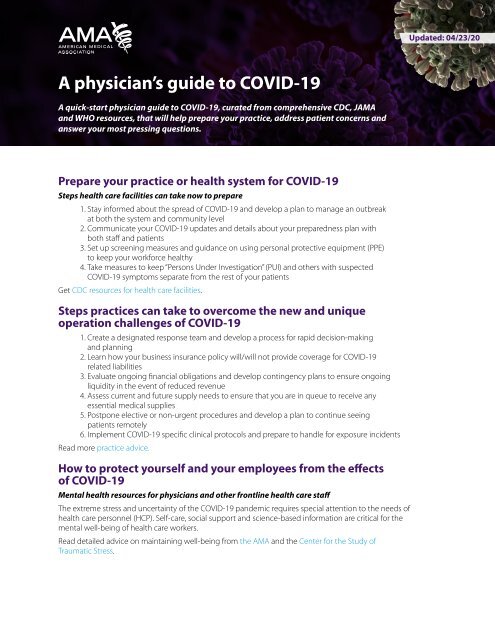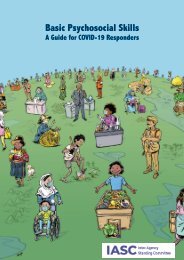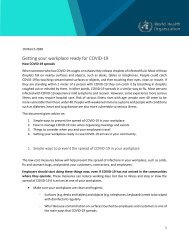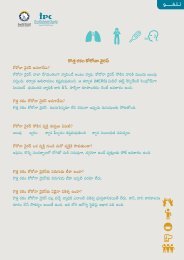A physician’s guide to COVID-19
A quick-start physician guide to COVID-19, curated from comprehensive CDC, JAMA and WHO resources, that will help prepare your practice, address patient concerns and answer your most pressing questions
A quick-start physician guide to COVID-19, curated from comprehensive CDC, JAMA
and WHO resources, that will help prepare your practice, address patient concerns and
answer your most pressing questions
You also want an ePaper? Increase the reach of your titles
YUMPU automatically turns print PDFs into web optimized ePapers that Google loves.
Updated: 04/23/20<br />
A <strong>physician’s</strong> <strong>guide</strong> <strong>to</strong> <strong>COVID</strong>-<strong>19</strong><br />
A quick-start physician <strong>guide</strong> <strong>to</strong> <strong>COVID</strong>-<strong>19</strong>, curated from comprehensive CDC, JAMA<br />
and WHO resources, that will help prepare your practice, address patient concerns and<br />
answer your most pressing questions.<br />
Prepare your practice or health system for <strong>COVID</strong>-<strong>19</strong><br />
Steps health care facilities can take now <strong>to</strong> prepare<br />
1. Stay informed about the spread of <strong>COVID</strong>-<strong>19</strong> and develop a plan <strong>to</strong> manage an outbreak<br />
at both the system and community level<br />
2. Communicate your <strong>COVID</strong>-<strong>19</strong> updates and details about your preparedness plan with<br />
both staff and patients<br />
3. Set up screening measures and guidance on using personal protective equipment (PPE)<br />
<strong>to</strong> keep your workforce healthy<br />
4. Take measures <strong>to</strong> keep “Persons Under Investigation” (PUI) and others with suspected<br />
<strong>COVID</strong>-<strong>19</strong> symp<strong>to</strong>ms separate from the rest of your patients<br />
Get CDC resources for health care facilities.<br />
Steps practices can take <strong>to</strong> overcome the new and unique<br />
operation challenges of <strong>COVID</strong>-<strong>19</strong><br />
1. Create a designated response team and develop a process for rapid decision-making<br />
and planning<br />
2. Learn how your business insurance policy will/will not provide coverage for <strong>COVID</strong>-<strong>19</strong><br />
related liabilities<br />
3. Evaluate ongoing financial obligations and develop contingency plans <strong>to</strong> ensure ongoing<br />
liquidity in the event of reduced revenue<br />
4. Assess current and future supply needs <strong>to</strong> ensure that you are in queue <strong>to</strong> receive any<br />
essential medical supplies<br />
5. Postpone elective or non-urgent procedures and develop a plan <strong>to</strong> continue seeing<br />
patients remotely<br />
6. Implement <strong>COVID</strong>-<strong>19</strong> specific clinical pro<strong>to</strong>cols and prepare <strong>to</strong> handle for exposure incidents<br />
Read more practice advice.<br />
How <strong>to</strong> protect yourself and your employees from the effects<br />
of <strong>COVID</strong>-<strong>19</strong><br />
Mental health resources for physicians and other frontline health care staff<br />
The extreme stress and uncertainty of the <strong>COVID</strong>-<strong>19</strong> pandemic requires special attention <strong>to</strong> the needs of<br />
health care personnel (HCP). Self-care, social support and science-based information are critical for the<br />
mental well-being of health care workers.<br />
Read detailed advice on maintaining well-being from the AMA and the Center for the Study of<br />
Traumatic Stress.
How <strong>to</strong> minimize exposure and implement standard and transmission-based precautions<br />
The CDC recommends specific measures <strong>to</strong> minimize the spread of infection that include:<br />
1. Following PPE <strong>guide</strong>lines<br />
2. Actively screening everyone for symp<strong>to</strong>ms of <strong>COVID</strong>-<strong>19</strong> before they enter your practice<br />
or health care facility<br />
3. Implementing comprehensive source control for all, regardless of symp<strong>to</strong>ms, <strong>to</strong><br />
prevent transmission from asymp<strong>to</strong>matic and pre-symp<strong>to</strong>matic individuals (Note: cloth<br />
masks may be appropriate for patients or visi<strong>to</strong>rs in this setting, but they should not be<br />
considered appropriate workforce PPE.)<br />
4. Foregoing contact tracing for exposures in favor of universal source control for HCP and<br />
screening for fever and symp<strong>to</strong>ms before every shift in areas with heightened community<br />
transmission<br />
5. Establish reporting within health care facilities and <strong>to</strong> public health authorities<br />
Read the full Interim Infection Prevention and Control Recommendations and the Strategies for<br />
Optimizing PPE<br />
Prioritizing urgent and emergency visits can help manage the supply of PPE<br />
The following actions can preserve protective equipment and patient care supplies, ensure staff and<br />
patient safety, and expand available hospital capacity during the <strong>COVID</strong>-<strong>19</strong> pandemic:<br />
• Delay all elective ambula<strong>to</strong>ry provider visits<br />
• Reschedule elective and non-urgent admissions<br />
• Delay inpatient and outpatient elective surgical and procedural cases<br />
• Urge patients <strong>to</strong> postpone routine dental and eyecare visits<br />
Read the full CDC information on optimizing the supply of N95 respira<strong>to</strong>rs and CMS<br />
recommendations on non-essential planned surgeries and procedures.<br />
Diagnosing and treating patients with <strong>COVID</strong>-<strong>19</strong><br />
Who should be tested for <strong>COVID</strong>-<strong>19</strong> and how <strong>to</strong> get them tested<br />
Clinicians should use their judgment <strong>to</strong> determine if a patient has signs and symp<strong>to</strong>ms compatible<br />
with <strong>COVID</strong>-<strong>19</strong> and whether the patient should be tested. Most patients with confirmed <strong>COVID</strong>-<strong>19</strong><br />
have developed fever and/or symp<strong>to</strong>ms of acute respira<strong>to</strong>ry illness (e.g., cough, difficulty breathing).<br />
Physicians should be aware that state and local health departments may adapt recommended<br />
testing <strong>guide</strong>lines <strong>to</strong> respond <strong>to</strong> rapidly changing local circumstances.<br />
Read the most recent <strong>COVID</strong>-<strong>19</strong> clinical criteria, which includes information on prioritizing testing.<br />
Health care professionals should immediately notify their local or state health department in the<br />
event of a PUI for <strong>COVID</strong>-<strong>19</strong>. Find your state and local health department contacts.<br />
What evidence-based therapeutic options are available for patients<br />
There are no U.S. Food and Drug Administration approved drugs specifically for the treatment of<br />
patients with <strong>COVID</strong>-<strong>19</strong>.<br />
Some patients with <strong>COVID</strong>-<strong>19</strong> have received intravenous remdesivir, an investigational antiviral drug<br />
that was reported <strong>to</strong> have in-vitro activity against SARS-CoV-2, for compassionate use outside of a<br />
clinical trial setting.<br />
Hydroxychloroquine and chloroquine are under investigation in clinical trials for pre-exposure or<br />
post-exposure prophylaxis of SARS-CoV-2 infection, and treatment of patients with mild <strong>to</strong> severe<br />
<strong>COVID</strong>-<strong>19</strong>. More information on clinical trials can be found at ClinicalTrials.gov.<br />
Read clinical guidance from the CDC as well as information on therapeutic options for <strong>COVID</strong>-<strong>19</strong><br />
patients.<br />
If an adverse drug event is suspected or observed from any medication used <strong>to</strong> prevent or treat<br />
<strong>COVID</strong>-<strong>19</strong>, health care providers should submit a report <strong>to</strong> FDA MedWatch with <strong>COVID</strong>-<strong>19</strong> or<br />
coronavirus referenced in the report.
Precautions <strong>to</strong> take for vulnerable patients<br />
As <strong>COVID</strong>-<strong>19</strong> is spread by person-<strong>to</strong>-person contact, limiting the impact of the virus on vulnerable<br />
patient populations, such as older adults and individuals with serious underlying medical conditions,<br />
may require specialized prevention measures.<br />
Read current advice on people at higher risk for serious illness from <strong>COVID</strong>-<strong>19</strong>.<br />
When <strong>to</strong> end home isolation for patients with <strong>COVID</strong>-<strong>19</strong><br />
Physicians now have two methods <strong>to</strong> determine the appropriateness of ending isolation. Options<br />
now include both a test-based strategy and a time-since-illness-onset and time-since-recovery<br />
(non-test-based) strategy.<br />
Read the full CDC interim guidance. There is separate guidance for individuals who are<br />
immunocompromised.<br />
What <strong>to</strong> do if you have been exposed <strong>to</strong> patients with<br />
<strong>COVID</strong>-<strong>19</strong><br />
How <strong>to</strong> assess of risk, moni<strong>to</strong>r for symp<strong>to</strong>ms and understand work restriction decisions for<br />
health care professionals with potential exposure <strong>to</strong> <strong>COVID</strong>-<strong>19</strong>.<br />
Health care professionals are at risk for exposure <strong>to</strong> <strong>COVID</strong>-<strong>19</strong>, whether in the workplace or in<br />
the community. The CDC recommends that facilities develop a plan <strong>to</strong> screen for symp<strong>to</strong>ms and<br />
evaluate ill health care professionals. The guidance also outlines the appropriate implementation<br />
of work restrictions based on risk assessment, with recognition that this guidance is not practical<br />
in all situations.<br />
Read Interim guidance for health care personnel from the CDC<br />
How <strong>to</strong> communicate with patients<br />
<strong>COVID</strong>-<strong>19</strong> facts <strong>to</strong> share with concerned patients<br />
Sharing facts on how the virus is spread and how <strong>to</strong> minimize exposure can help calm patient fears<br />
and prevent them from falling for popular myths.<br />
Explore CDC fact sheets and posters<br />
Read myths about <strong>COVID</strong>-<strong>19</strong> that physicians should be ready <strong>to</strong> debunk<br />
Stay up-<strong>to</strong>-date on current travel notices and restrictions from the CDC<br />
Advice <strong>to</strong> give patients who have suspected or confirmed <strong>COVID</strong>-<strong>19</strong><br />
Patients experiencing a fever, cough or other symp<strong>to</strong>ms of respira<strong>to</strong>ry illness that are common with<br />
<strong>COVID</strong>-<strong>19</strong> should stay home except <strong>to</strong> get medical care. Most patients with mild illness are able<br />
<strong>to</strong> recover at home. but should seek treatment immediately if should they experience emergency<br />
warning signs.<br />
Read more tips from CDC <strong>to</strong> prevent the spread of <strong>COVID</strong>-<strong>19</strong><br />
Coverage and benefits policies related <strong>to</strong> <strong>COVID</strong>-<strong>19</strong><br />
Learn what coverage options are available through CMS<br />
The Centers for Medicare & Medicaid Services (CMS) has issued a new frequently asked questions<br />
<strong>guide</strong> regarding coverage and payment for labora<strong>to</strong>ry tests and other services related <strong>to</strong> <strong>COVID</strong>-<strong>19</strong>.<br />
Read the CMS Medicare FAQ<br />
Read the CMS Medicaid FAQ<br />
Information related <strong>to</strong> <strong>COVID</strong>-<strong>19</strong> individual and small group market insurance coverage
Explore your CARES Act options<br />
The $2 trillion CARES Act contains numerous provisions designed <strong>to</strong> preserve the livelihood of<br />
physicians and mitigating the economic damage suffered by American practices, hospitals and<br />
other health care organizations.<br />
Learn more about CARES Act benefits and provisions for physicians and practices.<br />
Caring for patients through telehealth<br />
Develop a telehealth plan<br />
The temporary relaxation of regula<strong>to</strong>ry requirements under the Health Insurance Portability and<br />
Accountability Act (HIPAA), physicians will find it easier <strong>to</strong> quickly scale up their digital health offers<br />
<strong>to</strong> continue care for patients in quarantine or isolation.<br />
Read the AMA’s quick start <strong>guide</strong> <strong>to</strong> telemedicine <strong>to</strong> start implementing digital <strong>to</strong>ols in your practice.<br />
Explore the CMS Medicare Health Care Provider Fact Sheet for Telemedicine.<br />
© 2020 American Medical Association. All rights reserved.<br />
20-440690:4/20












